Sambar and rice as a combination is a favorite of mine. I’m sure it is also for a lot of other people too. But what if I give you a way to enjoy this pair, originally hurled up into a one-pot meal? Won’t it be all the more awesome? That’s what this delicious Sambar Rice recipe is all about. This Sambar Sadam is a lot like the famous Bisi Bele Bath of Karnataka in South India, just the taste is different. Try this way of having a comforting and healthy meal this time, go for it!
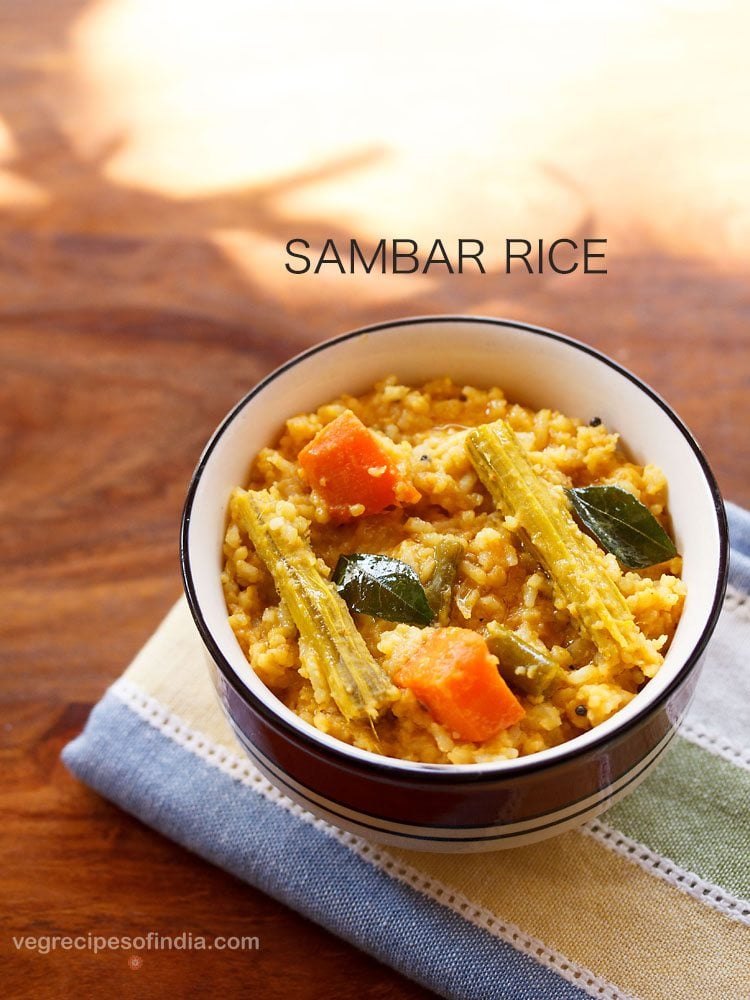
Table of Contents
About Sambar Rice
This is an easy Sambar Sadam, for which you really don’t have to be a master in the kitchen. Just get your preparation on point, as per the recipe list and you’re all set to make a really scrumptious bowl of comfort.
You begin by cooking and mashing the rice and dal, then onto making the veggie sambar and mixing both. The final step is to temper this mish-mash of Sambar Rice with the basic spices and curry leaves.
Just before serving, you can top it up with a spoonful of ghee for that ultimate experience.
While I am preparing this at home, sometimes I make the Sambar Sadam completely in a pressure cooker. Whereas, at times, I cook the vegetables separately. Cooking the vegetables separately method is what I have shared in this post.
More On My Recipe
Use whichever vegetables you like in this Sambar Rice. I have used carrots, potatoes, drumsticks, French beans and capsicum. Other veggies like ash gourd, yellow cucumber (sambar cucumber), brinjal/aubergine/eggplant and pumpkin can also be added.
Since this Sambar Sadam gets done as a one-pot thing, it also resembles a Khichdi in many ways. For instance, the consistency of this Sambar Rice can also be adjusted like a khichdi. If you want to make a slightly liquidy version, you can do it by adding more water. A semi-dry version by adding less water is also possible.
While I like my Sambar Rice, just the way it is, sometimes with fresh curd and appalams (papad). You can even relish it with a side vegetable dish or pickle. Dotting the dish with some ghee is also a great way to enhance the taste.
How to make Sambar Rice
Cook Rice and Lentils Together
1. Rinse together 1 cup rice and ½ cup pigeon pea lentils (arhar dal, tur dal or tuvar dal) a couple of times in water. Drain all the water and add both rice and dal in a 3 litre stovetop pressure cooker.
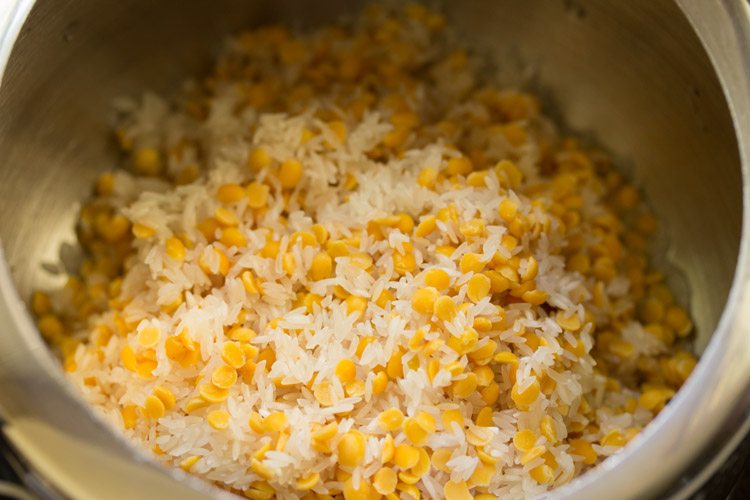
2. Season with ¼ teaspoon salt.
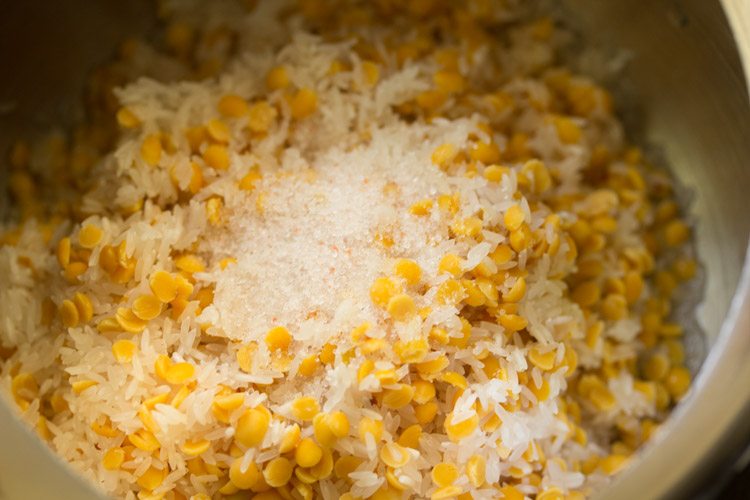
3. Add 3 cups water and 1 teaspoon sesame oil (gingelly oil).
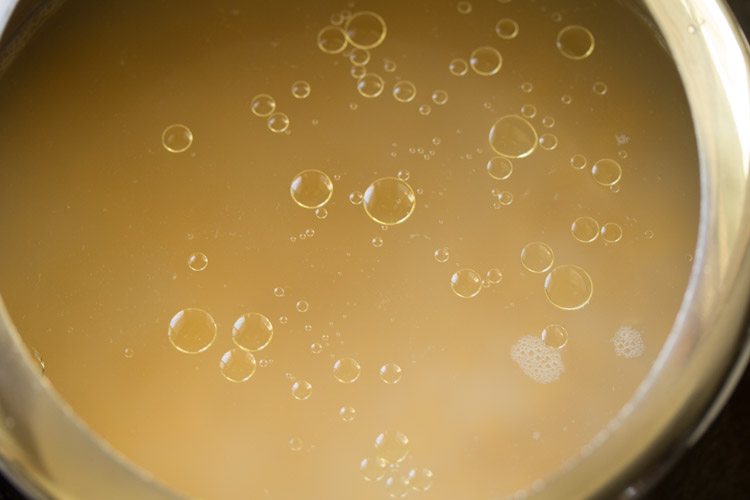
4. Pressure cook for 15 to 16 minutes on medium heat.
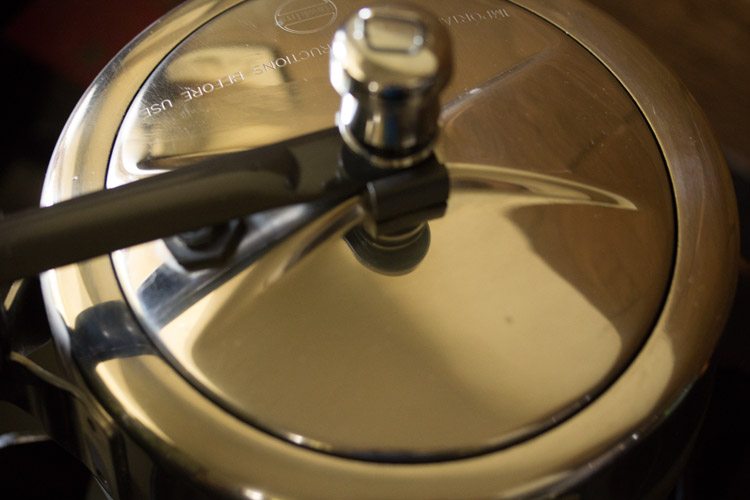
5. When the pressure settles down naturally, remove the lid and check if the rice and lentils are cooked.
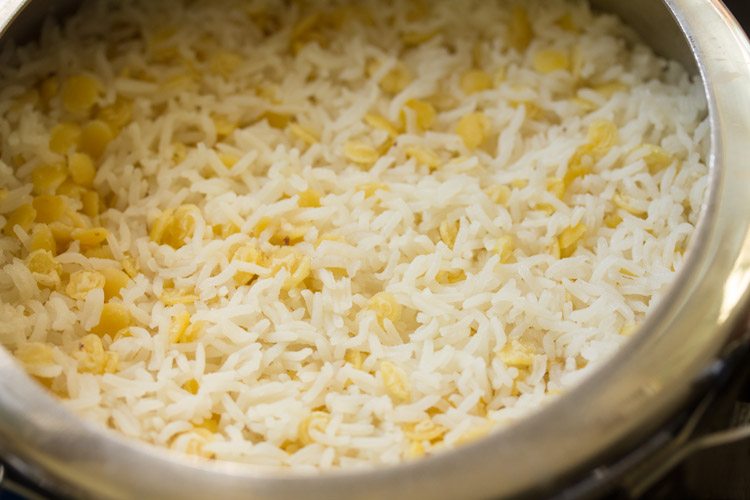
6. Mash lightly, cover and keep aside. In case the dal is not cooked, add some more water and pressure cook for some more time.
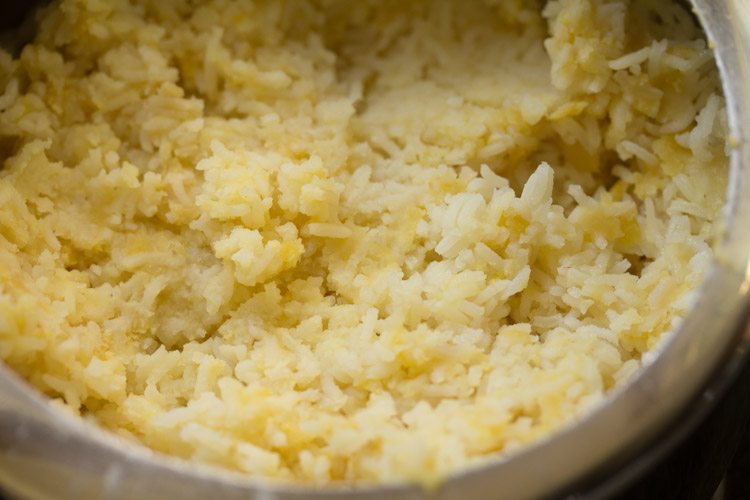
Make Tamarind Pulp
7. While the rice and dal are cooking, soak ½ tablespoon tightly packed tamarind in ⅓ cup hot water for about 20 to 30 minutes.
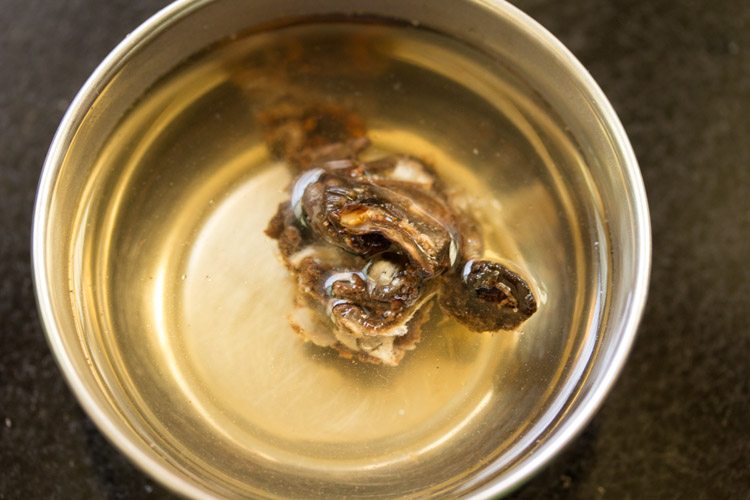
8. Later, squeeze the pulp from the tamarind and keep aside.
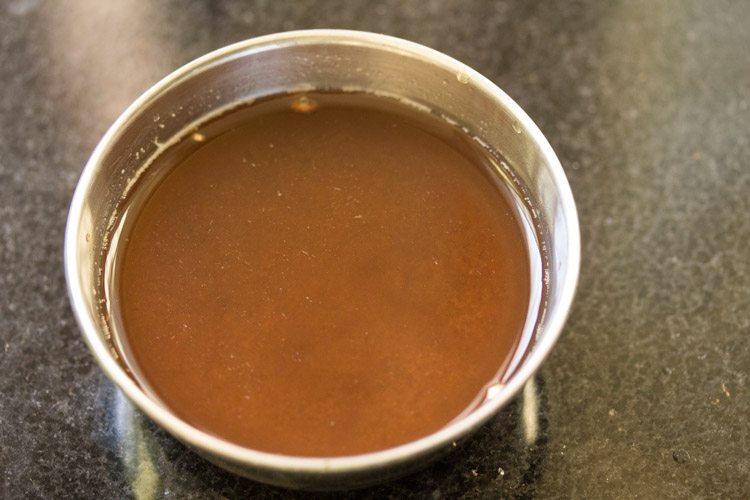
Cook Vegetables
9. While the rice and dal are cooking, you can also start to cook the vegetables. Heat 1 tablespoon sesame oil in a pan.
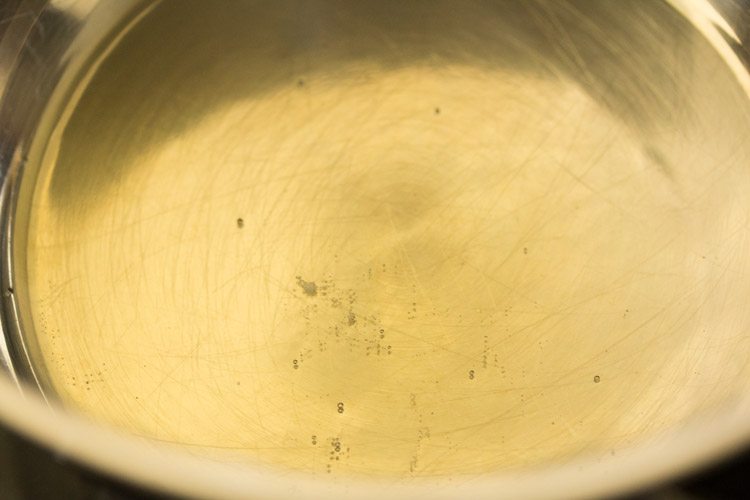
10. Add ⅓ cup thickly sliced onions. You can also use pearl onions or shallots.
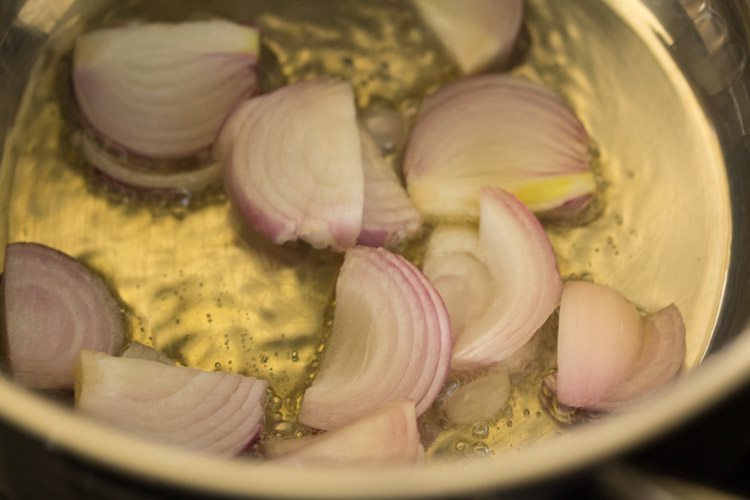
11. Sauté for 1 minute on low to medium heat.
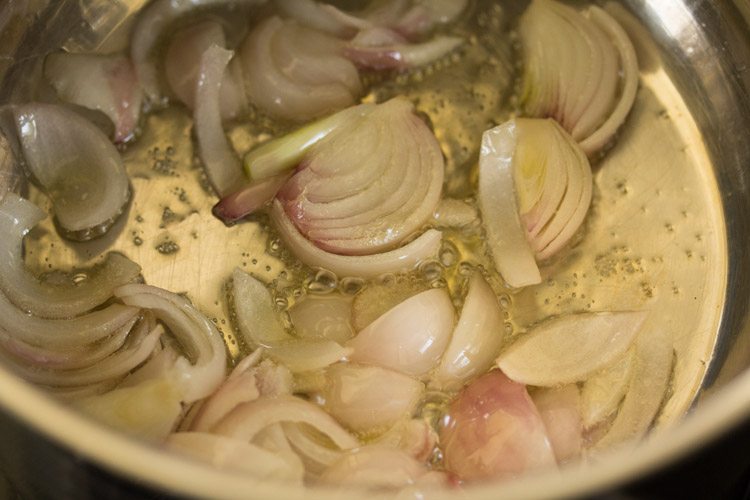
12. Then, add 5 to 6 curry leaves and 1 pinch asafoetida (hing).
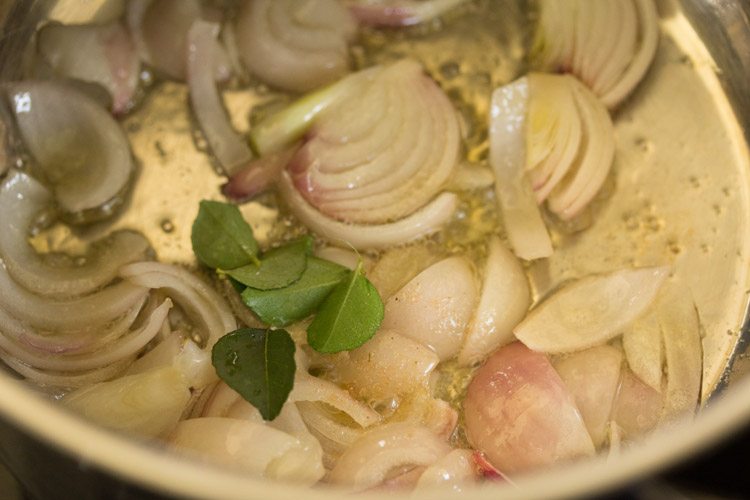
13. Sauté for a couple of seconds. Then, add ½ cup diced tomatoes.
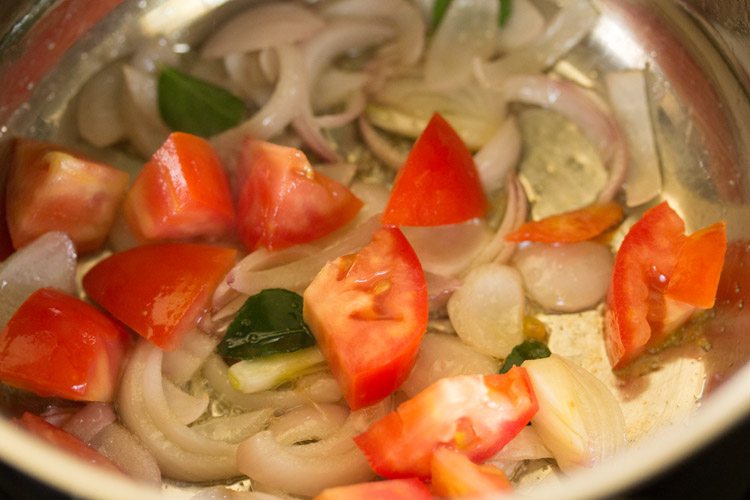
14. Mix and sauté tomatoes for 2 minutes.
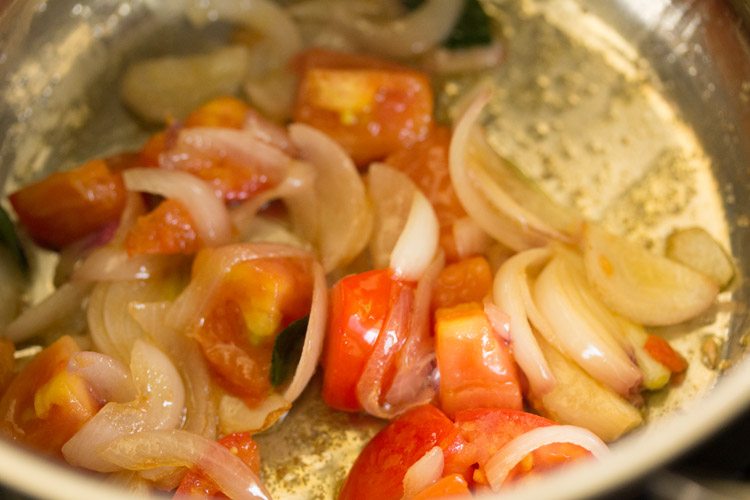
15. Then, add 1.5 cups chopped mixed vegetables like French beans, carrot, capsicum, brinjal, pumpkin and 1 medium to large drumstick.
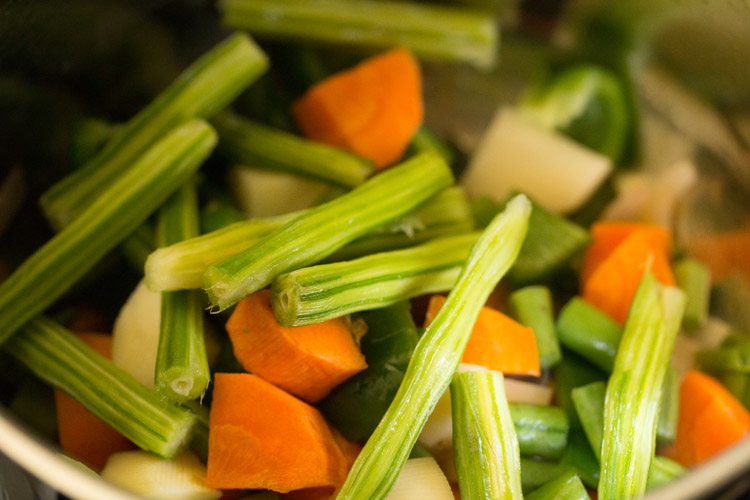
16. Sauté the vegetables for a minute.
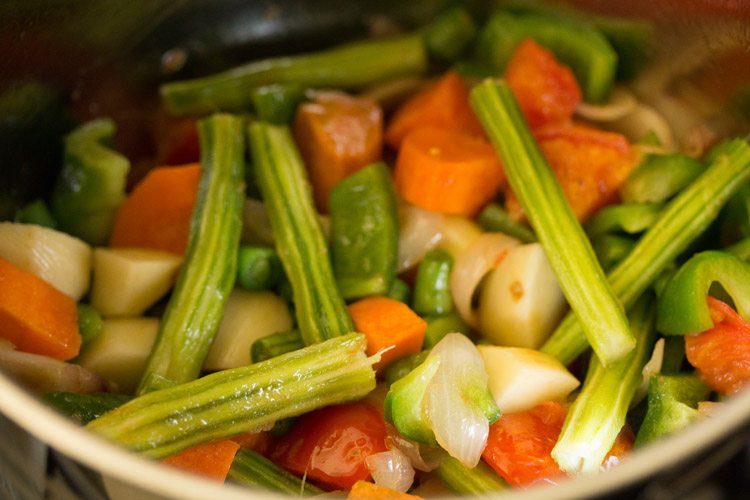
17. Add ½ teaspoon turmeric powder and ½ teaspoon Kashmiri red chili powder.
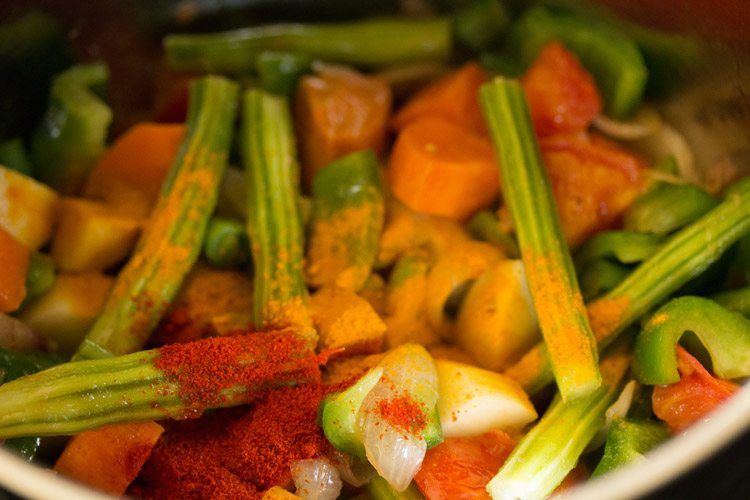
18. Mix again very well.
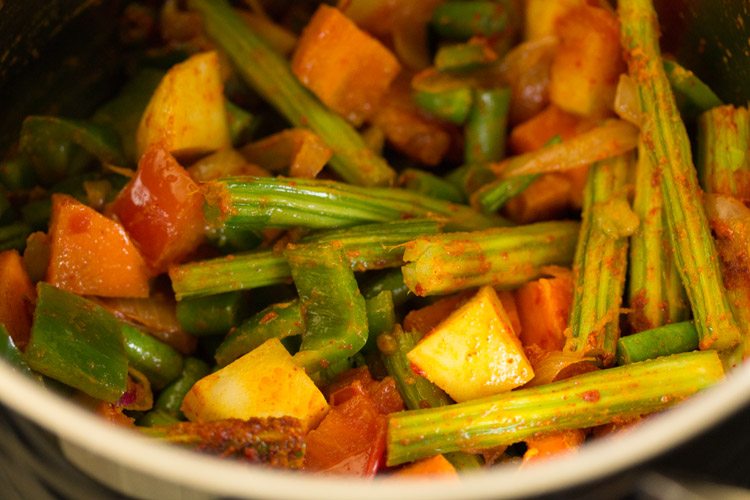
19. Now, add 2 to 2.5 cups water or add as required.
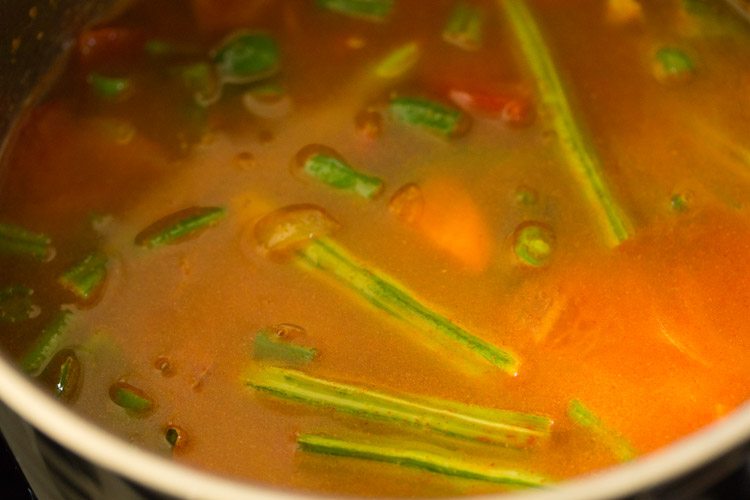
20. Season with salt as per taste.
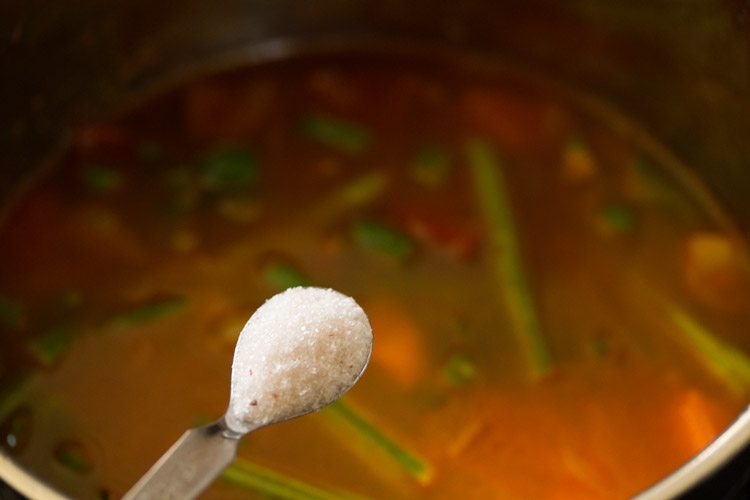
21. Stir well.
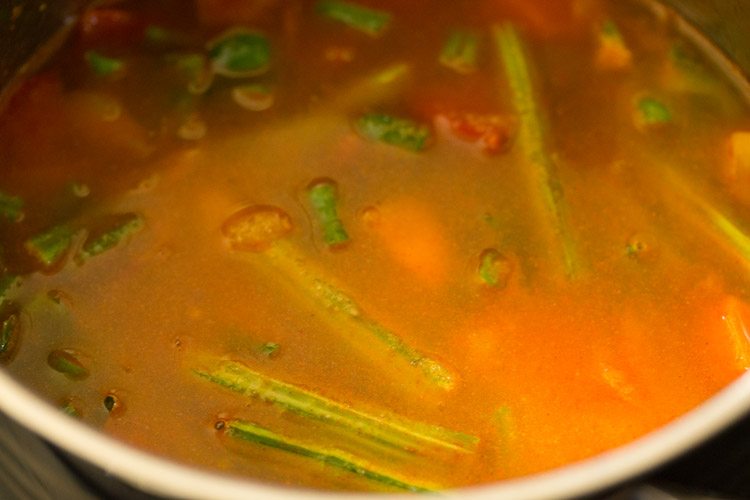
22. Cover the pan with a lid and cook the vegetables on medium-low to medium heat for 16 to 18 minutes. Check in between.
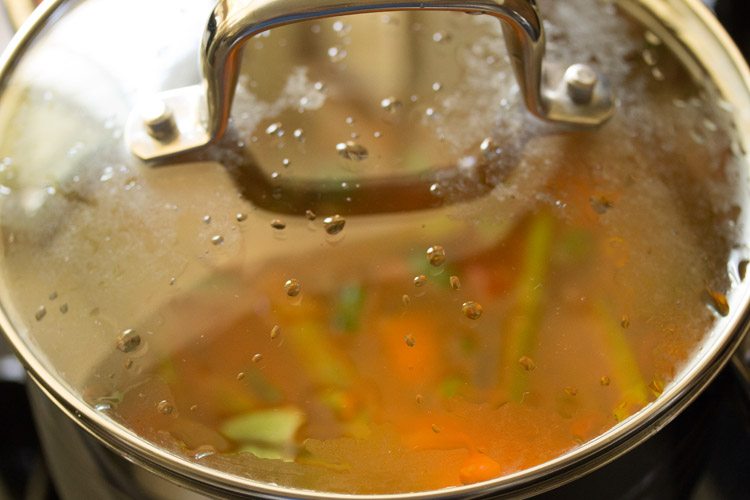
23. Simmer till the vegetables are almost cooked. Then, add the prepared tamarind pulp.
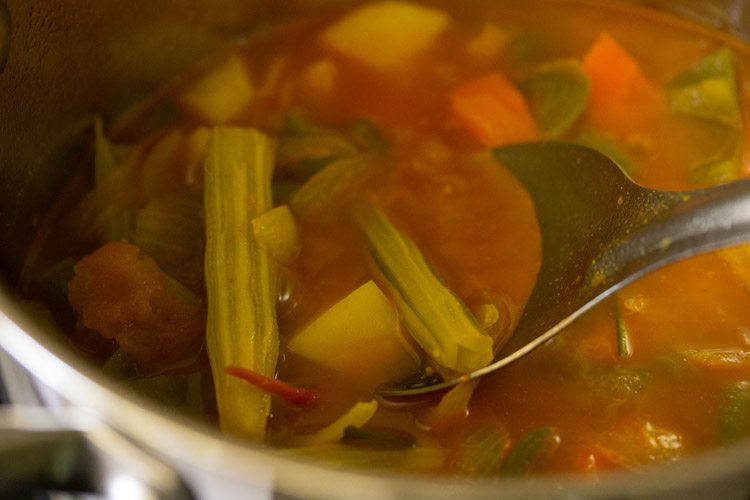
24. Next, add 1 tablespoon Sambar Powder. You can also add more sambar powder if you want. Mix very well.
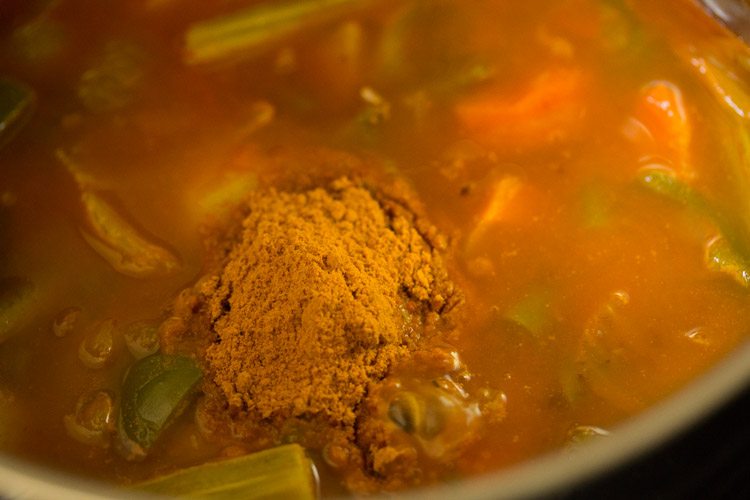
25. Cover and continue to cook till the vegetables are cooked well and the raw taste of tamarind goes away. So, cook for 8 to 9 minutes more on low to medium heat.
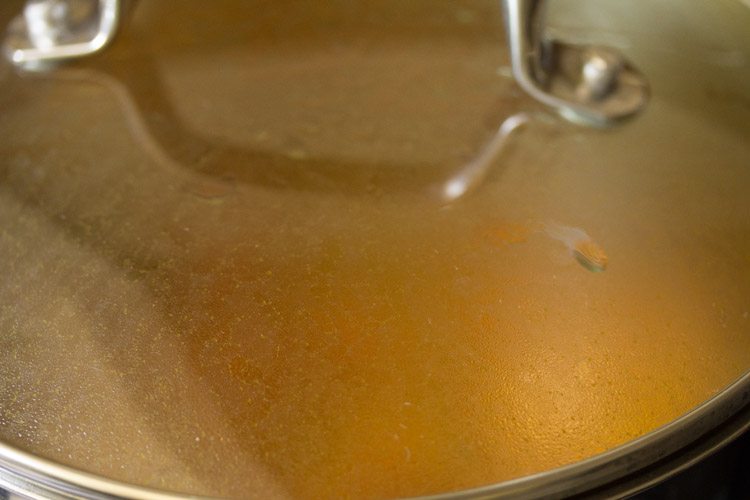
26. Check at intervals. Simmer till the vegetables are done and the raw taste of tamarind goes away.
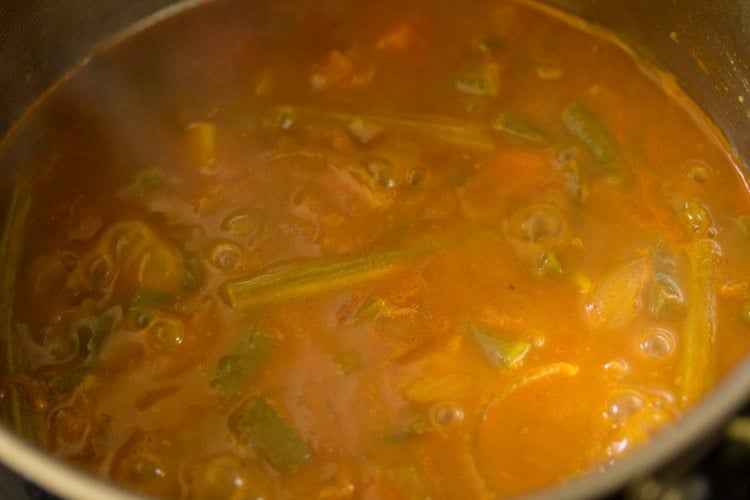
Make Sambar Rice
27. When the vegetables are cooked well, add the lightly mashed dal and rice.
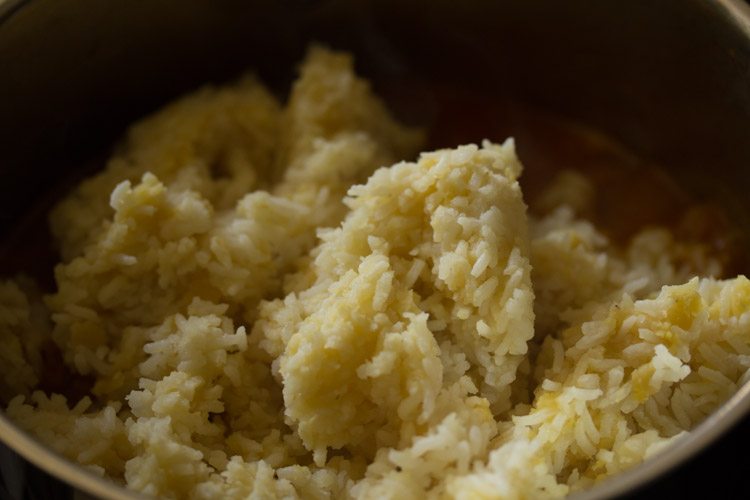
28. Mix everything well. If you want a more liquid consistency, then add some hot water at this step and mix well.
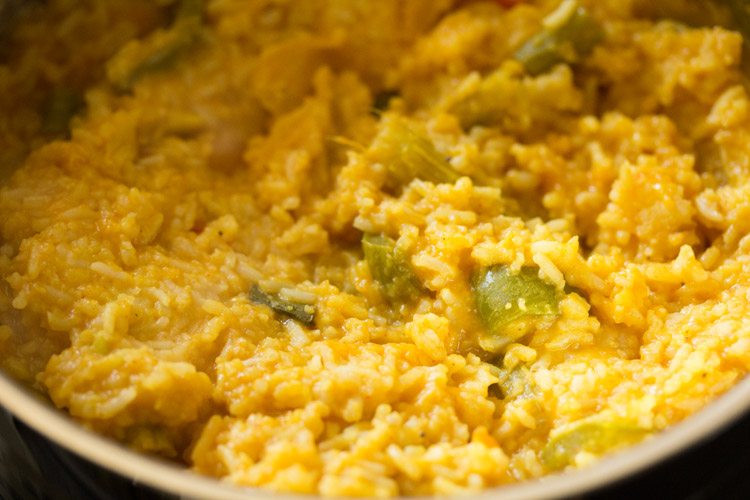
29. Next, add 1 tablespoon ghee. Mix again. Ghee can be skipped if you want. Check the taste and add more salt if required.
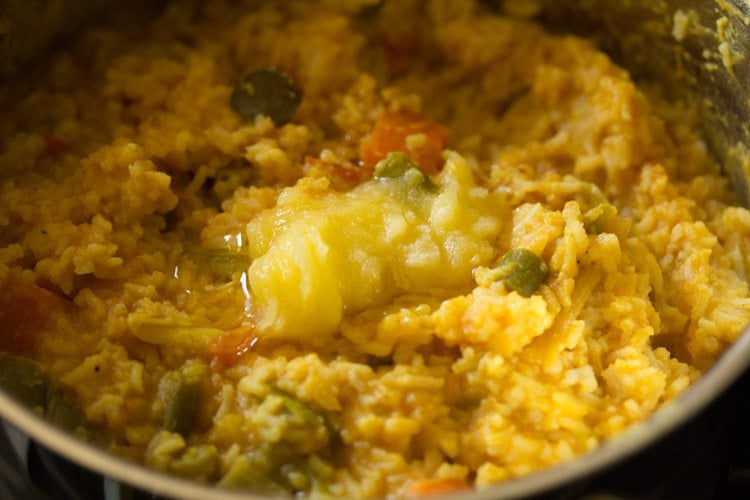
Make Tempering
30. Heat 2 tablespoons sesame oil in a tadka pan or a small frying pan. Add 1 teaspoon mustard seeds and let them crackle.
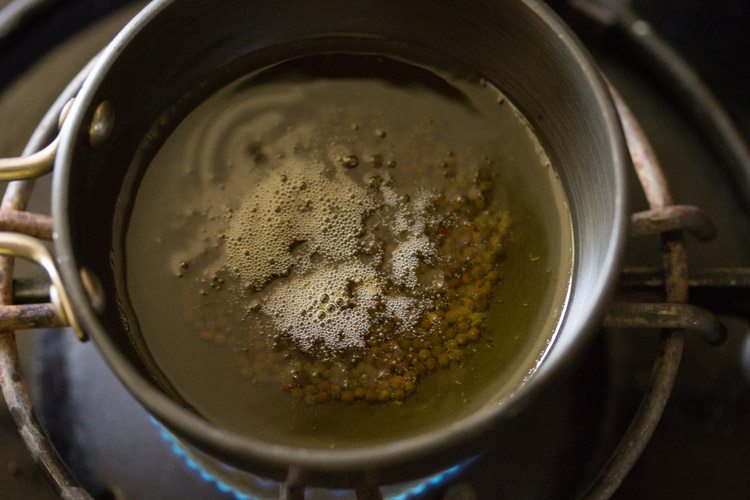
31. Then, add 3 to 4 dried red chilies (seeds removed), 12 to 15 curry leaves and 1 generous pinch asafoetida (hing).
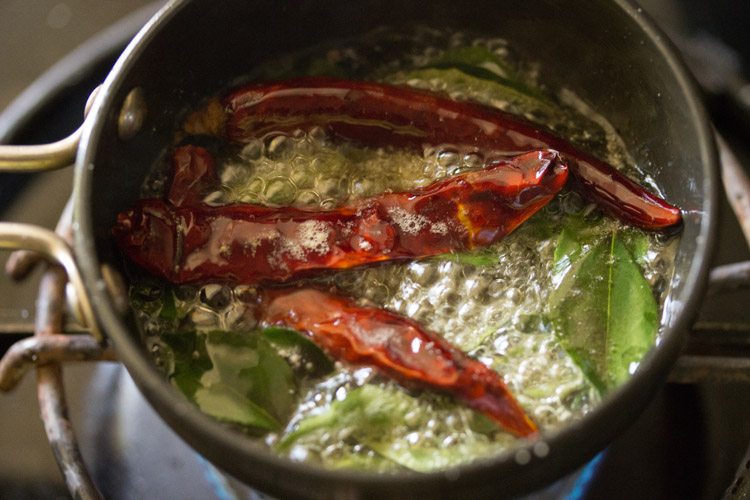
32. Stir and fry till the red chilies change color and become dark. Take care not to burn them.
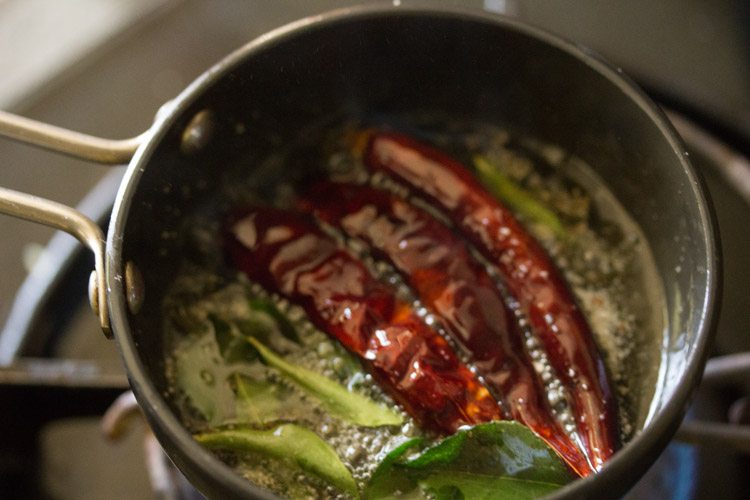
33. Pour the tempering with the oil on the Sambar Rice.
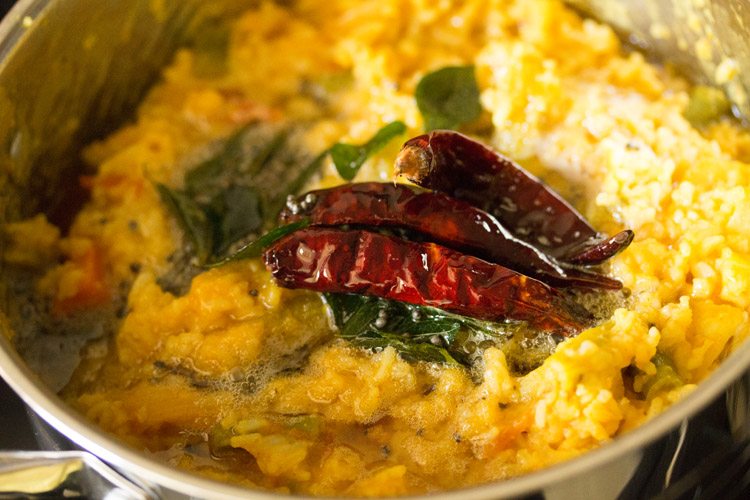
34. Mix very well.
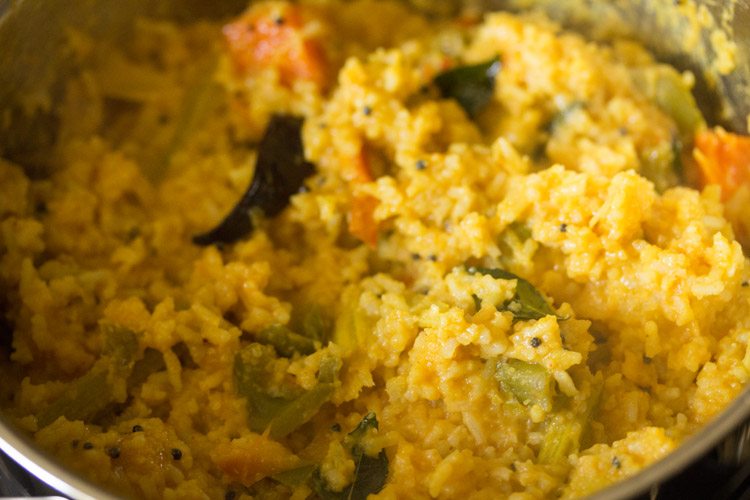
35. Serve Sambar Sadam plain or accompanied with a side vegetable dish, curd (yogurt), pickle or appalam (papadum). You can also dot it with some ghee while serving.
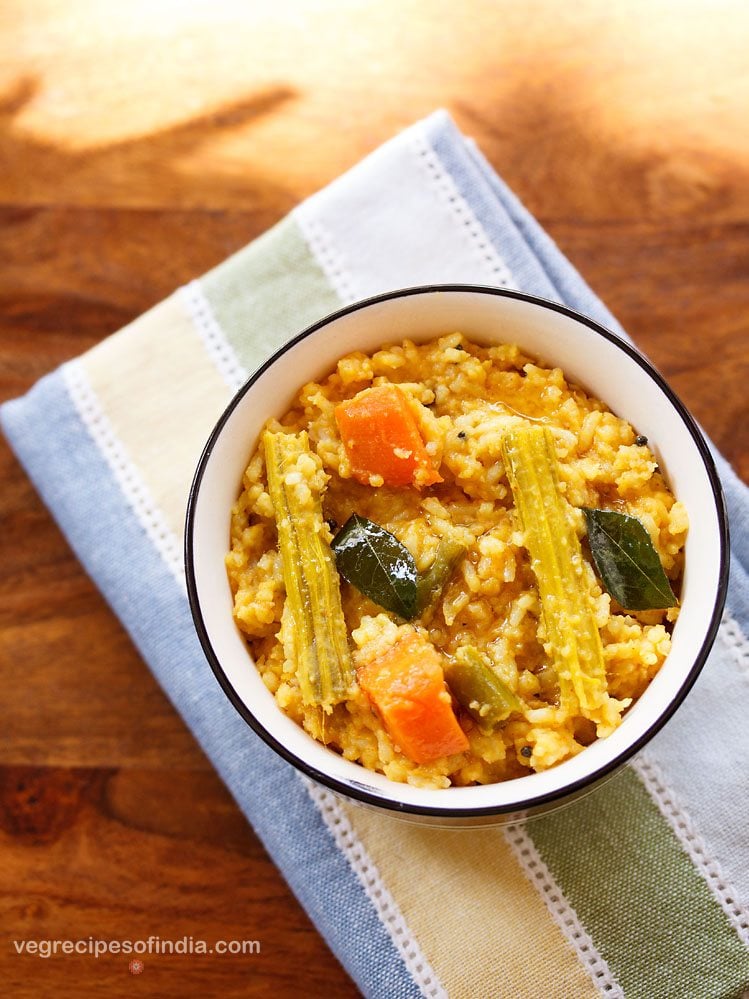
Expert Tips
- The more vegetables, the more wholesome this dish will be. The list is extensive – potato, carrot, brinjal, French beans, drumsticks, ash gourd, capsicum, pumpkin, yellow cucumber, etc. Choose from it or go with what you like.
- Since this dish is quite like a khichdi, you can use millets, quinoa, brown rice or other grains over your regular white rice, to make a more nutritious preparation.
- In case you have leftover cooked rice and lentils, you can use that as well to make this dish.
- Remember that on cooling, this dish will thicken. So, you’ll have to adjust the consistency by adding more or less water.
- You can use a store-bought sambar powder. But best will be to use the one that you’ve made yourself from scratch. For that, you can refer to my recipe of Sambar Masala.
- To make the tempering, you can use ghee in place of oil.
More Rice Recipes To Try!
Karnataka Recipes
Rice Recipes
Rice Recipes
Please be sure to rate the recipe in the recipe card or leave a comment below if you have made it. For more vegetarian inspirations, Sign Up for my emails or follow me on Instagram, Youtube, Facebook, Pinterest or Twitter.
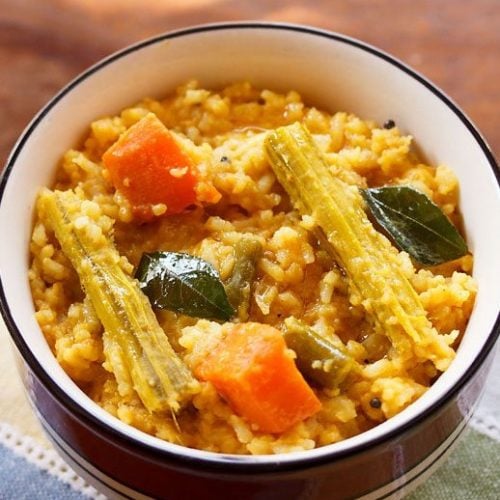
Sambar Rice | Sambar Sadam
Ingredients
For cooking rice and dal
- 1 cup rice
- ½ cup toor dal (tuvar dal, arhar dal or pigeon pea lentils)
- 3 cups water – for pressure cooking
- ¼ teaspoon salt
- 1 teaspoon sesame oil (gingelly oil)
For making tamarind pulp
- ½ tablespoon tightly packed tamarind
- ⅓ cup hot water
For cooking vegetables
- 1 tablespoon sesame oil (gingelly oil)
- ⅓ cup thickly sliced onions or pearl onions or shallots
- 5 to 6 curry leaves
- 1 pinch asafoetida (hing)
- ½ cup diced tomatoes
- 1.5 cups chopped mixed veggies – like french beans, carrots, capsicum, brinjal, pumpkin
- 1 drumstick (medium to large), use tender drumsticks
- ½ teaspoon turmeric powder (ground turmeric)
- ½ teaspoon kashmiri red chili powder or paprika
- 2 to 2.5 cups water or add as required
- salt as required
- 1 tablespoon Sambar Powder
- 1 tablespoon Ghee – optional
For tempering
- 2 tablespoons sesame oil (gingelly oil)
- 1 teaspoon mustard seeds
- 3 to 4 dry red chillies – halved and seeds removed
- 12 to 15 curry leaves
- 1 generous pinch asafoetida (hing)
For serving
- 2 to 3 teaspoons Ghee – optional
Instructions
Cooking rice and lentils
- Rinse together rice and toor dal (tuvar dal or pigeon pea lentils) a couple of times in water. Drain all the water and add both rice and dal in a 3 litre stovetop pressure cooker.
- Add ¼ teaspoon salt, 3 cups water and 1 teaspoon sesame oil.
- Pressure cook for 15 to 16 minutes on medium heat.
- When the pressure falls naturally on its own, remove the lid and check if the rice and lentils are cooked together.
- Mash lightly and keep aside covered. In case the lentils are undercooked, then add some more water and pressure cook for some more time.
Making tamarind pulp
- Meanwhile when the rice & lentils are cooking, soak ½ tablespoon tightly packed tamarind in ⅓ cup hot water for about 20 to 30 minutes.
- Later squeeze the tamarind pulp extract in the bowl of water and keep aside.
Cooking veggies
- So when the lentils and rice are cooking, you can also start to prep and cook the veggies. Heat 1 tablespoon sesame oil in a pan.
- Add ⅓ cup thickly sliced onions. You can also use pearl onions or shallots.
- Sauté for 1 minute on a low to medium heat.
- Then add 5 to 6 curry leaves (kadi patta) and 1 pinch of asafoetida (hing).
- Sauté for a couple of seconds then add ½ cup diced tomatoes. Mix and saute tomatoes for 2 minutes.
- Next add 1.5 cups chopped mixed veggies like french beans, carrots, capsicum, brinjal, pumpkin and 1 medium to large drumstick. Sauté the veggies for a minute.
- Add ½ teaspoon turmeric powder and ½ teaspoon kashmiri red chili powder. Mix again very well.
- Now add 2 to 2.5 cups water or add as required.
- Season with salt as per taste. Stir to mix.
- Cover the pan with a lid and cook the veggies on medium-low to medium heat for 16 to 18 minutes. Do check in between.
- Simmer till the veggies are almost cooked. Then add the tamarind pulp.
- Next add 1 tablespoon sambar powder. You can also add more sambar powder if you want. Mix very well.
- Continue to cover and cook till the veggies are cooked well and the raw taste of tamarind disappears. So cook for a further 5 to 6 minutes or more on low to medium heat.
Making sambar rice
- When the veggies are cooked tender and softened, then add the lightly mashed dal and rice.
- Mix everything thoroughly. if you want a more liquid consistency in sambar rice then add some hot water at this step and then mix again.
- Then add 1 tablespoon ghee. Ghee can be skipped if you want.
- Mix again. Check the taste and add more salt if needed.
Making tempering
- Heat 2 tablespoons sesame oil in a tadka pan or a small frying pan. Add 1 teaspoon mustard seeds and let them crackle.
- Then add 3 to 4 dry red chilies, 12 to 15 curry leaves and 1 generous pinch of asafoetida (hing).
- Stir and fry till the red chilies change their color and become dark. Take care not to burn them.
- Pour this entire tempering mixture on the sambar rice. Mix very well.
- Serve sambar sadam plain or you can accompany with a side veggie dish, curd (yogurt), pickle or appalam (papaddums). You can also dot with some ghee while serving.
Notes
- Preferably use unpolished tuvar dal for the best taste, flavor and nutrition.
- You can omit adding sesame oil and use any of your preferred neutral flavored oil. You could also use ghee entirely in the recipe instead of sesame oil.
- Add your choice of vegetables.
- Use a good brand of sambar powder or a fragrant homemade sambar masala.
- The lentils and rice can also be cooked in the Instant Pot. The vegetables can be steamed using the PIP (Pot in Pot method) when the rice and lentils are cooking.
Nutrition Info (Approximate Values)
This Sambar Rice recipe from the archives first published in October 2017 has been republished and updated on November 2022.
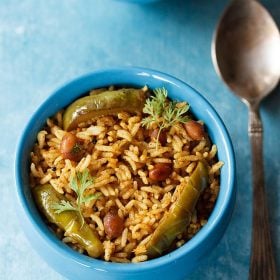
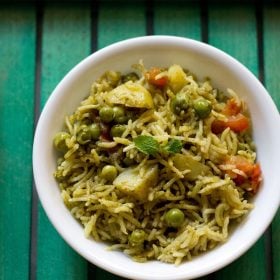
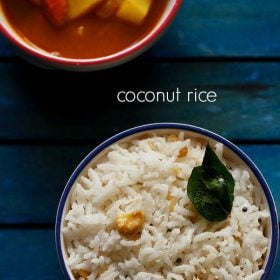
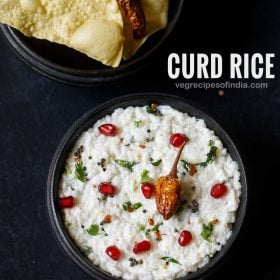








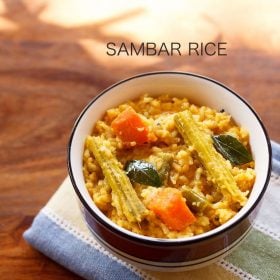
Can I get some receipes for diabetic
there are some recipe for diabetics but i have not made any category. will try to add a category in some time.